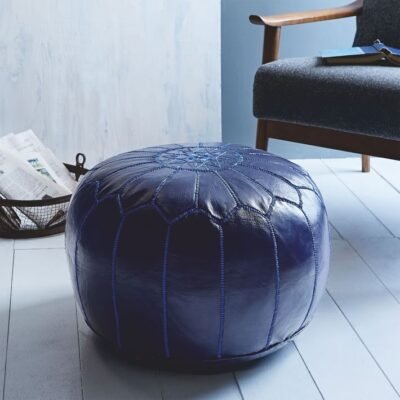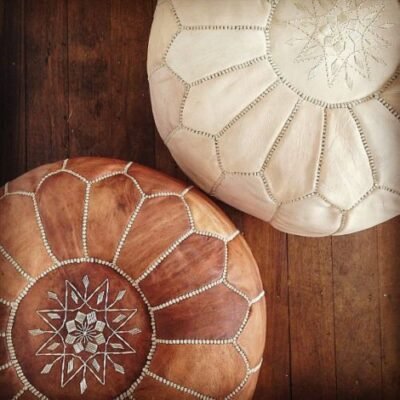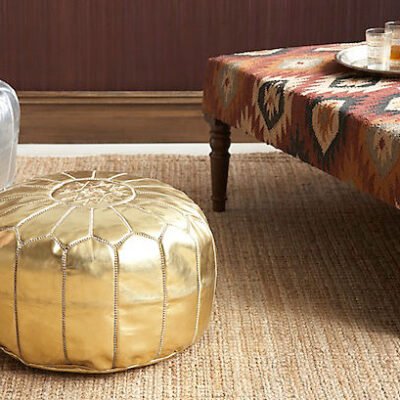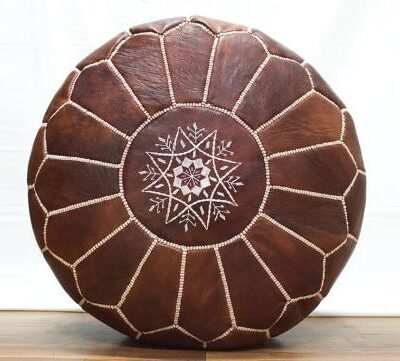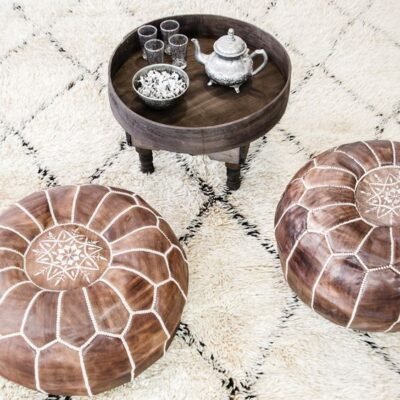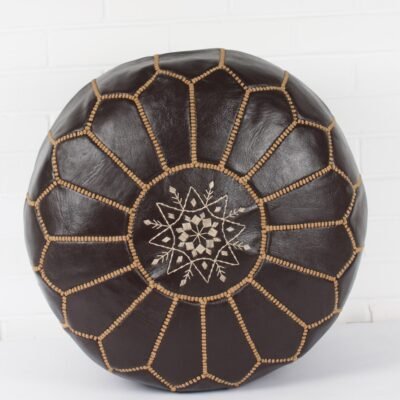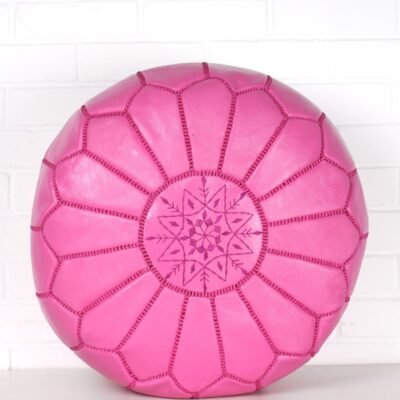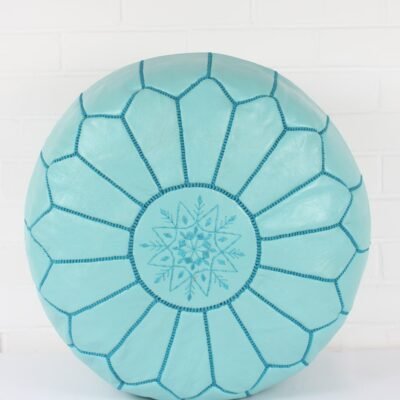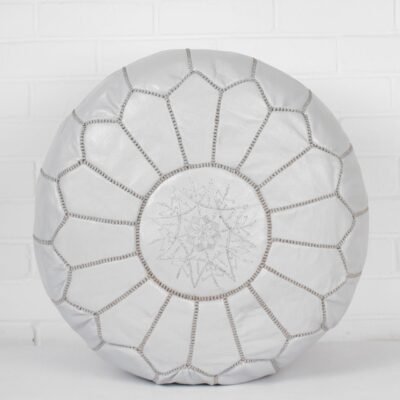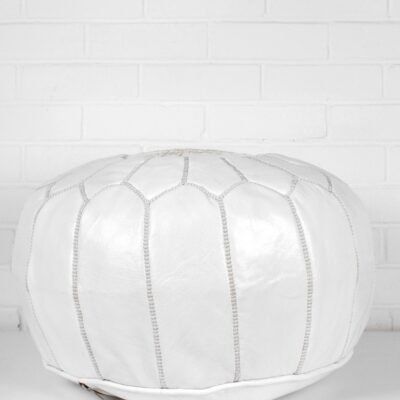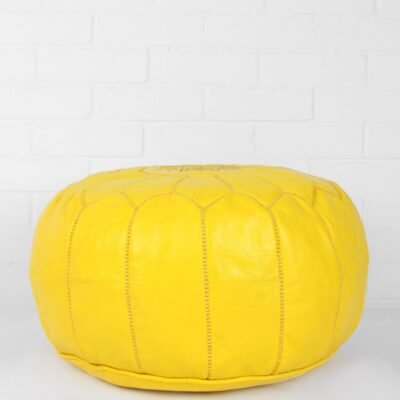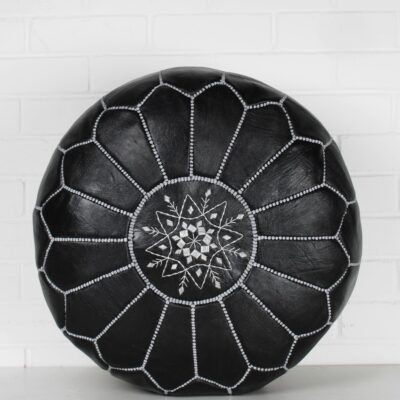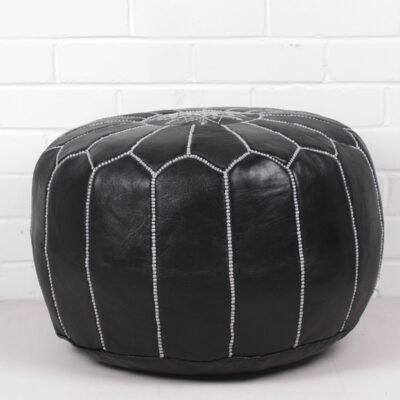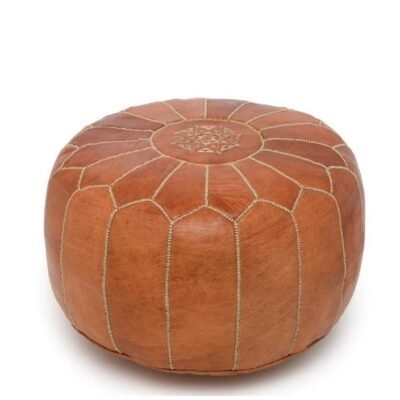The History of Moroccan Leather Craftsmanship
Moroccan leather craftsmanship dates back centuries, with its origins deeply rooted in the country’s rich history and culture. The art of leatherworking in Morocco is a tradition that has been refined over generations, with skills passed down from master craftsmen to apprentices. This tradition has been central to Moroccan society, contributing significantly to its economy and cultural identity.
The city of Fez, in particular, is renowned for its leather tanning industry. The tanneries in Fez are among the oldest in the world, with methods and techniques that have remained largely unchanged since medieval times. Here, artisans use natural processes to treat and dye the leather, employing materials like pigeon droppings and natural dyes to achieve the softness and vibrant colors that Moroccan leather is known for.
This historical backdrop sets the stage for the creation of Moroccan poufs. The craftsmanship involved in making these poufs is a direct descendant of the ancient leatherworking traditions of Morocco. Artisans today still adhere to the traditional techniques, ensuring that each pouf is a representation of Morocco’s rich artisanal heritage.
Cultural Importance in Moroccan Homes and Ceremonies
In Moroccan culture, the pouf is more than just a decorative item; it is a symbol of hospitality and communal living. Moroccan homes are designed to be welcoming spaces, with seating arrangements that encourage gathering and social interaction. The pouf, with its low profile and versatility, fits perfectly into this ethos, providing a comfortable space for guests to sit and engage in conversation.
Moreover, Moroccan poufs play a significant role in ceremonies and celebrations. They are often used during weddings and feasts, arranged around low tables to create an intimate setting for dining and socializing. The pouf’s portability and flexibility make it an ideal choice for such occasions, embodying the Moroccan spirit of hospitality and community.
This cultural significance is intertwined with the aesthetic and functional aspects of the pouf, making it a cherished item in Moroccan homes. It is a piece that carries with it the warmth and welcoming nature of Moroccan culture, inviting those who use it to partake in a tradition of communal living and celebration.
Artisan Techniques in Pouf Making
The creation of a Moroccan pouf is a labor-intensive process that requires skill, patience, and a deep understanding of traditional leatherworking techniques. Artisans begin with the selection of high-quality leather, which is then tanned using natural methods. This is a crucial step in the process, as it determines the softness and durability of the leather.
Once the leather is prepared, it is dyed using natural dyes derived from plants and minerals. This not only gives the poufs their vibrant colors but also ensures that they are environmentally friendly. The dyeing process is an art in itself, with artisans carefully selecting and mixing dyes to achieve the desired hues.
The next step involves cutting the leather into pieces that will be stitched together to form the pouf. This requires precision, as the pieces must fit together perfectly to create a seamless finish. The stitching is done by hand, using traditional techniques that have been honed over centuries. This not only ensures the durability of the pouf but also adds to its aesthetic appeal, with the hand-stitched seams becoming a feature of the design.
Tanning and Dyeing the Leather Poufs
Tanning and dyeing are pivotal steps in the production of Moroccan leather poufs, setting the foundation for their durability and vibrant appearance. The tanning process in Morocco is renowned for its use of natural materials and methods, which not only imbue the leather with a distinct softness but also with an eco-friendly footprint. Artisans utilize a variety of natural tannins, derived from bark and plants, which lend the leather its resilience and characteristic texture.
Following tanning, the leather undergoes the dyeing process, where it is transformed with rich, deep colors that are a hallmark of Moroccan craftsmanship. This step is particularly noteworthy for its reliance on natural dyes, which are made from plants, minerals, and sometimes even insects. These natural dyes not only contribute to the pouf’s aesthetic appeal but also ensure that the production process remains environmentally sustainable.
The techniques used in tanning and dyeing are a testament to the Moroccan commitment to craftsmanship and sustainability. They reflect a harmony between tradition and environmental consciousness, which is increasingly relevant in today’s global market. The result is not just a product but a piece of Moroccan heritage, imbued with the natural beauty and ecological ethics of its place of origin.
Leather Poufs: Stitching and Embellishments
Once the leather is tanned and dyed, the next phase involves stitching and embellishing, which are crucial for adding character and uniqueness to each pouf. Moroccan artisans are skilled in the art of leather stitching, employing techniques that have been passed down through generations. The stitching is not merely functional but also an element of design, often featuring intricate patterns that are characteristic of Moroccan artistry.
Embellishments play a significant role in the final appearance of the pouf. Artisans may use embroidery, appliqué, or additional leather pieces to create decorative patterns and motifs. These embellishments are not random but are deeply rooted in Moroccan culture, often drawing inspiration from Islamic art, nature, and traditional Moroccan designs.
The combination of stitching and embellishments is what sets Moroccan poufs apart from mass-produced alternatives. Each pouf is a work of art, reflecting the individual artisan’s skill and the rich cultural heritage of Morocco. This attention to detail ensures that no two poufs are exactly alike, offering a unique piece of Moroccan art for any interior.
Color Choices and What They Mean
The color of a Moroccan pouf is not just a matter of aesthetic preference but also carries cultural and symbolic meanings. Moroccan artisans traditionally use a palette of vibrant colors, each with its own significance. For example, red is often associated with strength and protection, while blue symbolizes wisdom and tranquility. Green, significant in Islamic culture, represents paradise and peace.
In choosing the color of a pouf, artisans and buyers alike are participating in a tradition that goes beyond mere decoration. The colors chosen for a pouf can reflect the owner’s personality, intentions, or the desired ambiance for the space. This aspect of Moroccan pouf craftsmanship adds another layer of depth to these beautiful pieces, making them not just furniture but a means of expression and cultural connection.
Furthermore, the natural dyes used in coloring the leather further enhance the pouf's connection to Moroccan traditions and the natural world. This conscious choice of materials and colors reflects a broader cultural emphasis on harmony with nature and respect for traditional practices, making each pouf a vibrant piece of Moroccan heritage.
Materials for Handmade Poufs: Types of Leather and Their Qualities
The quality of a Moroccan pouf is largely determined by the type of leather used in its creation. Moroccan artisans typically use goat, cow, or camel leather, each offering different textures and durability. Goat leather is prized for its softness and flexibility, making it ideal for poufs that are both comfortable and resilient. Cow leather, being thicker, provides a sturdier structure, while camel leather is renowned for its durability and unique grain pattern.
The choice of leather affects not only the pouf's aesthetic appeal but also its functionality and longevity. Artisans select the leather based on the intended use of the pouf, whether it is for seating, as a footstool, or purely decorative. This thoughtful selection process ensures that each pouf is not only beautiful but also perfectly suited to its role in the home.
Moreover, the use of natural leather contributes to the sustainability of Moroccan poufs. By choosing materials that are locally sourced and processed using traditional methods, artisans minimize the environmental impact of their work. This commitment to eco-friendly practices is a key aspect of the Moroccan leather industry, reflecting a broader cultural value of living in harmony with the natural world.
Poufs: Non-Leather Alternatives
While leather is the traditional material for Moroccan poufs, there are also non-leather alternatives that cater to different preferences and ethical considerations. These alternatives include cotton, wool, and synthetic fabrics, which are used to create poufs that are vegan-friendly and suitable for a wider range of interiors.
Non-leather poufs often feature the same intricate designs and craftsmanship as their leather counterparts, with artisans employing similar techniques of stitching and embellishment. These poufs can be just as vibrant and decorative, offering an eco-conscious option for those who prefer not to use animal products.
Choosing a non-leather pouf does not mean compromising on quality or design. These alternatives provide the same versatility and functionality, serving as seating, footstools, or decorative elements. They also reflect the adaptability of Moroccan craftsmanship, demonstrating how traditional techniques can be applied to a variety of materials to meet contemporary needs and values.
Tips for Choosing the Right Moroccan Pouf for Your Space
Selecting the right Moroccan pouf for your space involves considering several factors, including size, color, material, and design. The size of the pouf should be appropriate for the intended use and the available space, whether it is to serve as extra seating or a decorative accent. The color and design should complement the existing decor, creating a cohesive look that enhances the overall aesthetic of the room.
When choosing a pouf, it's also important to consider the quality of craftsmanship. Authentic Moroccan poufs, made by skilled artisans using traditional techniques, offer a level of detail and durability that is difficult to replicate. Opting for a handmade pouf ensures that you are getting a piece that is not only beautiful but also a reflection of Morocco's rich artisanal heritage.
Finally, sustainability and ethical practices should be taken into account. Choosing a pouf made from natural, sustainably sourced materials, and produced in a manner that supports local artisans, contributes to the preservation of traditional crafts and the well-being of the communities that create them.
The Role of Sustainability and Ethical Practices in the Production of Moroccan Poufs
Sustainability and ethical practices play a crucial role in the production of Moroccan poufs. Artisans and producers are increasingly aware of the importance of using eco-friendly materials and methods, ensuring that the creation of poufs has a minimal environmental impact. This includes the use of natural dyes, sustainable leather sourcing, and the promotion of fair labor practices.
Ethical production also involves supporting the artisan communities that create these poufs. By ensuring fair wages and working conditions, producers contribute to the preservation of traditional crafts and the economic well-being of Moroccan artisans. This commitment to ethical practices not only enhances the quality of the poufs but also ensures that they are produced in a manner that respects both people and the planet.
Choosing a Moroccan pouf from a source that values sustainability and ethics supports these important principles. It allows consumers to enjoy the beauty and craftsmanship of Moroccan poufs while contributing to a more sustainable and equitable world.
Where to Buy Authentic Moroccan Poufs: Alesouk
For those looking to purchase authentic Moroccan poufs, Alesouk offers a wide selection of handmade poufs crafted by skilled artisans. Alesouk specializes in traditional Moroccan crafts, ensuring that each pouf is made using time-honored techniques and materials. Their commitment to quality, sustainability, and ethical practices makes Alesouk an ideal source for those seeking genuine Moroccan poufs.
By choosing Alesouk, customers not only receive a beautiful, high-quality pouf but also support the artisans and communities that create them. Alesouk's focus on authenticity and craftsmanship ensures that each pouf is a true representation of Moroccan artistry, suitable for any space that values unique, handcrafted decor.
Conclusion: Summarizing the Beauty and Utility of Moroccan Poufs for Your Interior
Moroccan poufs embody the perfect blend of beauty, utility, and tradition. These handcrafted pieces bring a touch of Moroccan culture and craftsmanship into any space, offering versatile seating options and a vibrant accent to interior decor. The process of creating a Moroccan pouf, from tanning and dyeing the leather to stitching and embellishing, reflects a deep respect for traditional techniques and materials.
Choosing the right Moroccan pouf involves considering factors such as size, color, material, and design, as well as the sustainability and ethical practices behind its production. By selecting a pouf that aligns with these considerations, consumers can enjoy a piece that is not only aesthetically pleasing but also meaningful and respectful of the environment and artisan communities.
Moroccan poufs are more than just furniture; they are a testament to the enduring value of handmade crafts and the cultural heritage of Morocco. Whether used as seating, a footstool, or a decorative element, a Moroccan pouf adds warmth, color, and texture to any room, making it a versatile and cherished addition to your interior.

